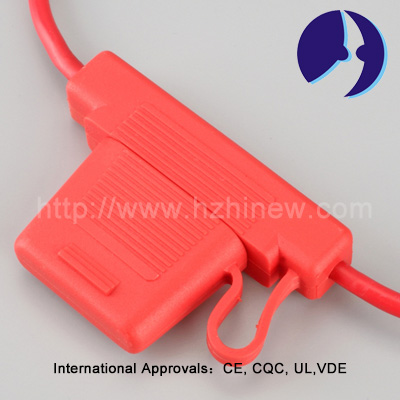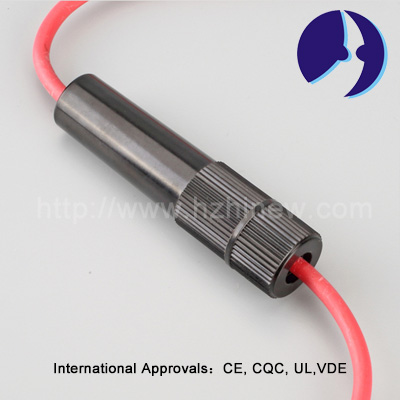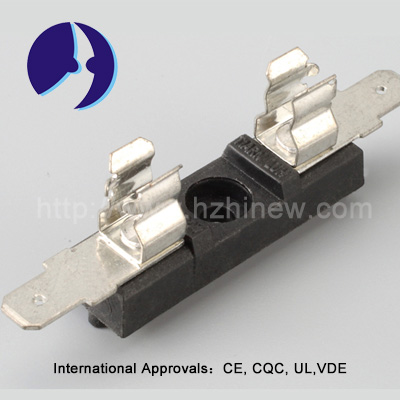Specification for panel mount fuse holder
1. What parameters are involved in the selection of fuses?
Several authoritative testing and accreditation institutions, such as UL accreditation of American insurance companies, CSA accreditation of Canadian Standards Association, MTTI accreditation of Japan’s Ministry of International Trade and Industry and ICE accreditation of the International Electrical Technology Commission.
The selection of fuse involves the following factors:
- 1. normal working current.
- 2. the applied voltage applied to the fuse.
- 3. requires abnormal current disconnected by the fuse.
- 4. allow the shortest and longest time that the abnormal current exists.
- 5. the ambient temperature of the fuse.
- 6. pulse, impulse current, surge current, starting current and circuit transient value.
- 7. is there any special requirement that exceeds the specification of fuse?
- 8. size limit of installation structure.
- 9. certification bodies required.
- 10. fuse holder: fuse clip, mounting box, panel installation, etc.
2、 Choose the meaning of fuse.
Here are some common parameters and terms for fuse selection.
Normal operating current: The current rating of the fuse is usually reduced by 25% to avoid harmful fusing when operating at 25 C. Most traditional fuse materials have low melting temperature. Therefore, the fuse is sensitive to the change of ambient temperature.
For example, a fuse with a current rating of 10A cannot normally operate at temperatures greater than 7.5A at 25 C. Voltage rating: the voltage rating of the fuse must be equal to or greater than the effective circuit voltage. The general standard voltage ratings are 32V, 125V, 250V and 600V.
Fuses have different voltage levels, for example, in the same rated current, 10kV fuses and 220V fuses are very different, although the same current can make it fuse, but if the voltage is too high, the fuse break can not guarantee insulation safety.
So high voltage fuse can be used in low voltage, but low pressure can not be used on high voltage. Resistance: the resistance of the fuse is not very important in the whole circuit. But there will be several ohms for the resistance of the fuse whose ampere number is less than
1、 so this problem should be considered when using the fuse in low voltage circuits. Most of the fuse is made of positive temperature coefficient material, so there are also cold resistance and thermal resistance.
Ambient temperature: the current carrying capacity of the fuse, its experiment is carried out at ambient temperature of 25′, this experiment is affected by ambient temperature changes. The higher the ambient temperature, the higher the working temperature of the fuse, the lower the current carrying capacity of the fuse, and the shorter the life of the fuse. Conversely, the life of the fuse will be extended at lower temperatures.
Fusing rated capacity: also known as breaking capacity. Fusing rated capacity is the maximum allowable current for fuse to fuse at rated voltage. In short circuit, the fuse will pass through the transient overload current more frequently than the normal working current. Safe operation requires that the fuse be kept intact (without bursting or breaking).
Fuse performance: The fuse performance refers to the fuse to a variety of current load response to the rapid extent. The fuse is usually divided into four types: normal response, delayed disconnection, fast action and current limitation.
Harmful circuit breakers are often caused by incomplete analysis of the designed circuit. Of all the factors involved in the fuse selection listed above, special attention must be paid to normal operating current, ambient temperature and overload. In use, the fuse can not only be selected according to the normal working current and ambient temperature, but also pay attention to other operating conditions. For example, a common cause of harmful circuit breaks in conventional power supplies is that the nominal melting heat rating of the fuse is not fully taken into account and must be met.
2 、the surge current generated by the input capacitor of the power smoothing filter puts forward the requirements for the fuse. If you want the fuse to work safely and reliably, then choose the fuse melting heat is not greater than 20% of the nominal melting heat rating of the fuse.
Nominal melting heat energy: refers to the energy needed to melt the fused parts, expressed in I2t, read as “ampere square seconds”. Melting heat testing is usually performed in authoritative certification bodies: a current increment is applied to the fuse and the melting time is measured. If the melting does not occur within about 0.008 seconds or longer, the intensity of the pulse current is increased.
Repeat the experiment until the fuse time is less than 0.008 seconds. The purpose of this test is to ensure that the heat generated does not have enough time to run away from the fuse parts through heat conduction, that is, all the heat can be used to fuse the fuse. Therefore, when choosing the fuse, in addition to the normal working current mentioned above, reduce the rated value, ambient temperature, but also consider the I2t value.
Also note that most fuses have welded joints, so be careful when welding these fuses. Because too much welding heat will make the solder in the fuse return and change its rating. The fuse is similar to a semiconductor thermosensitive element, so it is better to use an endothermic device when welding the fuse.
Hinew fuse holder types:
Automobile fuse holder
Panel Mount Fuse Holder
PCB board mounting fuse holder
Post time: Aug-31-2018




